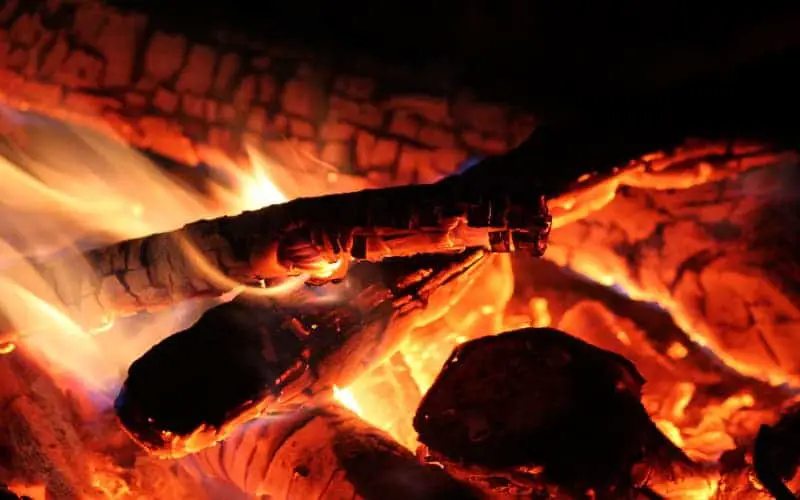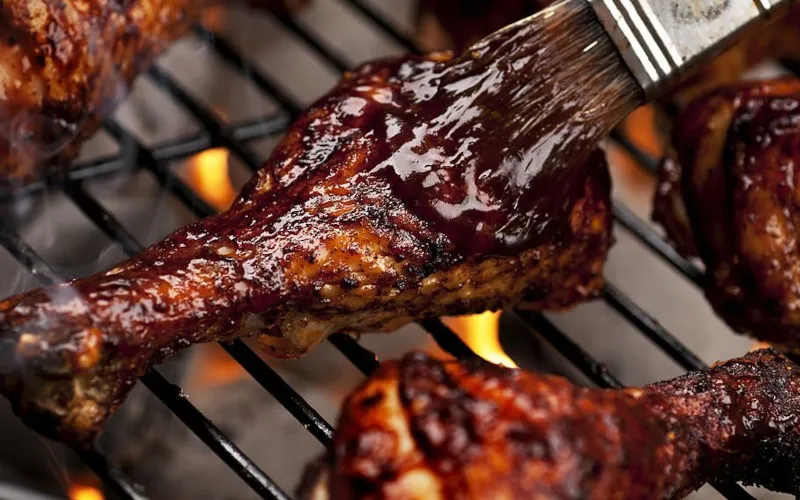It may seem silly to ask if smoked salmon is raw or not, but many customers are unsure what these terms imply in relation to food. It’s vital to understand that a product can be both raw and smoked at the same time; however, this does not necessarily guarantee that it is safe to eat.
If you’re interested in finding out whether or not smoked salmon is actually raw, keep reading!
Is Smoked Salmon Cooked Or Raw?
A smoked salmon is a form of cured salmon that has been smoked. Because hot-smoked smoked salmon has been fully cooked, it isn’t always raw. Hot-smoked salmon is fantastic for dips and pairs well with mayo on crackers with a squeeze of lemon.
Cold-smoked salmon, on the other hand, is uncooked and has a smokey flavor, much like lox. Cold-smoked salmon tastes wonderful on a bagel, but don’t restrict yourself to that. It’s also delicious in pasta, an omelet, or even as a pizza topping.
So what does smoking do to salmon? Well, in short, it cooks it and makes sure that any bacteria present on the surface of your fillet is killed off before you eat it.
As well as killing off any nasties, smoking also gives your salmon a wonderful smoky flavor. Smoking can be done either hot or cold depending on how much smoke you want to impart into your fish.
Cold-smoking (normally done at 90 degrees Fahrenheit) takes much longer than hot-smoking and so is usually used for meat products such as ham rather than fish. Hot smoking, which is more common for fish, involves heating up your smoker to around 120 degrees Fahrenheit which will cook your salmon more quickly.
Once you have smoked your salmon you will notice that it has changed color and looks darker than when it was fresh.
This color change is down to two things:
- Smoking changes the protein structure of your fish, making it firmer.
- Smoking adds chemicals called nitrosamines which give smoked food its distinctive coloring.
Related: How Long Does Smoked Meat Last?
Is Smoked Salmon Safe To Eat?
Yes. Most smoked salmon products have been cured in a brine of salt and sugar before being cold-smoked over low heat, which is how they get their signature color and delicious flavor. The curing process means that smoked salmon is safe to eat.
However, it’s still important to take care when eating any kind of fish because it can contain mercury or other contaminants that can be harmful if consumed in large quantities.
If you’re pregnant or breastfeeding, it’s especially important to avoid certain types of fish that are known to contain high levels of mercury—like swordfish and tuna—and stick with lower-mercury choices like wild Alaskan salmon instead.
Benefits of Eating Smoked Salmon
One of the greatest perks of eating smoked salmon is that it is healthier than its salted, cured, and boiled counterpart. Compared to boiled salmon, you can also expect a greater level of omega-3 fatty acids in smoked salmon which have been linked to preventing heart disease and cancer.
Another perk of eating smoked salmon is that it is higher in protein than other types of fish. The protein content can vary depending on how much fat there is on your piece of salmon, but as a general rule smoked salmon will be higher in protein compared to other fish like tuna or cod.
In addition to being high in protein, smoked salmon has an impressive amount of vitamins A and D, niacin (vitamin B), riboflavin (vitamin B), and selenium. All these nutrients combined make for one healthy meal.
How To Store Smoked Salmon?
There are many different ways to store smoked salmon, but these tips will keep it as fresh as possible and make sure that you can eat it when you want. If your salmon comes in vacuum-sealed packs, leave them sealed until ready to eat. Vacuum-sealed packaging will help keep it fresh longer than other forms of packaging- in this state, smoked salmon can be refrigerated for two to three weeks.
Once opened, wrap portions individually with plastic wrap or aluminum foil. You can also place a sheet of parchment paper on top of a plate before placing a portion on top. This keeps the fish from sticking to the plate.
Make sure that all surfaces are covered tightly so air cannot get in. You should plan on refrigerating your smoked salmon for not more than one week after opening it.
How To Serve Smoked Salmon As A Starter?
If you’re a fan of smoked salmon, it can be a real treat to serve your friends and family with some salmon appetizers. It’s extremely easy to make them and they look great.
Here are a few ideas for serving smoked salmon:
- Thinly sliced smoked salmon (if it’s a fatty cut, you can use a paper towel to pat it dry first). Top with crème fraîche and chopped chives. Serve alongside thin slices of baguette. Or, go Southwestern by topping with guacamole, pico de gallo, and crumbled cotija cheese.
- Prepare a bagel for an easy breakfast or snack idea. Spread with cream cheese, top with thinly sliced cucumber and capers, then add a squeeze of lemon juice before eating. Or, layer smoked salmon with cream cheese and chopped red onion in between two slices of rye bread.
- Top your favorite cracker (or whole-grain toast) with smoked salmon, some crumbled goat cheese, and a drizzle of olive oil—and maybe even some fresh herbs if you have them on hand.
- Use as an appetizer or part of a buffet spread at parties or events. Smoked salmon is delicious in salads or served alongside other seafood such as crab cakes or shrimp cocktails. It also goes well with other meats like roast beef or turkey, especially when it’s paired with cream cheese, capers, and dill relish. And don’t forget to top it off with sliced cucumbers for crunch.
- You can also pair smoked salmon with a variety of sauces. For example, you can top it with pico de gallo or chopped capers and serve alongside lime wedges for drizzling. Or, you can make a quick mustard sauce by mixing equal parts Dijon mustard and honey with a squeeze of lemon juice before serving.
- If you’re looking to use smoked salmon in the main dish recipe, consider pairing it with pasta or potatoes (or both). Try making baked macaroni and cheese topped with diced smoked salmon instead of bacon bits—it’s just as tasty!
Frequently Asked Questions
Do You Have To Cook Smoked Salmon?
The short answer is no. As long as you’re getting your salmon from a reputable source, it’s safe to eat smoked salmon without cooking it. Some people prefer to cook their salmon, but that’s a matter of personal preference.
Cooking smoked salmon can make it taste less salty and oily, but if you want to eat it raw, there are ways to do so safely. Most important is making sure your salmon comes from a trusted source and hasn’t been sitting around for too long before you buy it.
If you don’t know where your fish came from or how long ago it was packaged, don’t risk eating smoked fish—cooking is always safer than eating uncooked seafood.
Is Frozen Raw Salmon Safe To Eat?
Yes, frozen raw salmon is safe to eat. In fact, it’s perfectly safe to buy frozen fish and seafood in general. Freezing helps keep fish fresher for longer by slowing down or stopping bacterial growth.
Some types of seafood are flash-frozen shortly after they’re caught, which means you can buy them fresh and then freeze them yourself if you don’t want to cook them right away. Similar to smoked salmon, just make sure your frozen salmon comes from a reputable source and hasn’t been sitting around for too long before you buy it.
Can You Eat Costco Frozen Salmon Raw?
Yes, Costco is a highly reputable brand known for selling high-quality frozen seafood. If you’re looking to eat raw salmon, it’s best to go with a well-known source that can be trusted. Buying from a well-known retailer like Costco will give you peace of mind that your fish has been handled properly and hasn’t been sitting around too long before you buy it.
It also means you can feel safe buying frozen fish in general—not just salmon—because it comes from a trustworthy source.
Can You Eat Raw Salmon From Trader Joe’s?
Trader Joe’s is another great place to buy frozen salmon. They sell a variety of frozen seafood, so you can pick up different types of fish and seafood if you want to try some different things. Like Costco, they’re a well-known retailer that sells high-quality food at reasonable prices.
If you’re looking for a place to buy raw salmon or any other type of fish or seafood, then look no further than your local Trader Joe’s.
Is Smoked Salmon Healthy?
Smoked salmon is generally considered a healthy food. It’s often high in protein and low in calories, making it a good choice for anyone looking to lose weight or eat healthier. Just remember that smoked salmon is still processed food, so you should limit your intake of it just like you would any other type of fish or seafood.
If you’re trying to lose weight, stick to eating one serving per day (about three ounces). If you’re not trying to lose weight, then enjoy as much smoked salmon as you want—just make sure it comes from a reputable source and hasn’t been sitting around too long before you buy it.
Does Smoked Salmon Go Bad In The Fridge?
No, smoked salmon will last longer in your fridge (2-3 weeks) than other types of fish or seafood. The high-fat content in smoked salmon helps it stay fresh longer and slows down bacterial growth. This also means you should eat it soon after you buy it to make sure it tastes at its best.
That said, if you can’t finish a whole pack of smoked salmon then don’t worry—it will still taste just as good a few days later as long as you make sure to keep it refrigerated at all times.
Is Cold Smoked Salmon Safe To Eat?
Cold smoked salmon is safe to eat, but it’s generally not smokier than hot smoked salmon. Cold smoking can make fish fresher and less smoky in some cases. For example, cold-smoked salmon has a milder flavor and fewer calories than regular salmon because cold smoking doesn’t cook or heat up fish as hot smoking does.
It also means you can safely eat cold-smoked salmon raw or cooked without worrying about food poisoning—it won’t be any riskier than any other type of fresh seafood or fish.
Can You Eat Smoked Salmon In Sushi?
Yes, but you can’t buy smoked salmon at your local grocery store and expect it to be sushi-grade. Sushi-grade fish has to be very fresh and should never smell fishy. It should also have no discoloration or bruising—or any part of it that’s green.
If you can, look for smoked salmon that comes in plastic pouches instead of foil packaging because there’s a better chance they took extra steps to ensure it was sushi-quality. Just remember that if something looks too good to be true then there’s probably a reason for it.
Conclusion
Smoked salmon isn’t raw. The smoking process is done at a temperature that kills any bacteria and other microorganisms. However, as with all meat products, you should always check to make sure your salmon has been stored properly to avoid any contamination during transportation or storage.
It’s also important to note that there are different types of smoked salmon available on grocery store shelves—cold-smoked and hot-smoked—and they’re not interchangeable in recipes (you’ll want to use cold-smoked for things like cream cheese spreads and hot-smoked salmon for things like lox).
In general, if you stick to reputable brands and follow proper food safety guidelines when handling foods, you shouldn’t have anything to worry about when consuming smoked salmon.
That said, if any part of your experience with smoked salmon has made you question its safety—or if you just want to be extra careful—it’s best to err on the side of caution by avoiding processed meats altogether. You can get plenty of protein from other sources without worrying about potential health risks.





